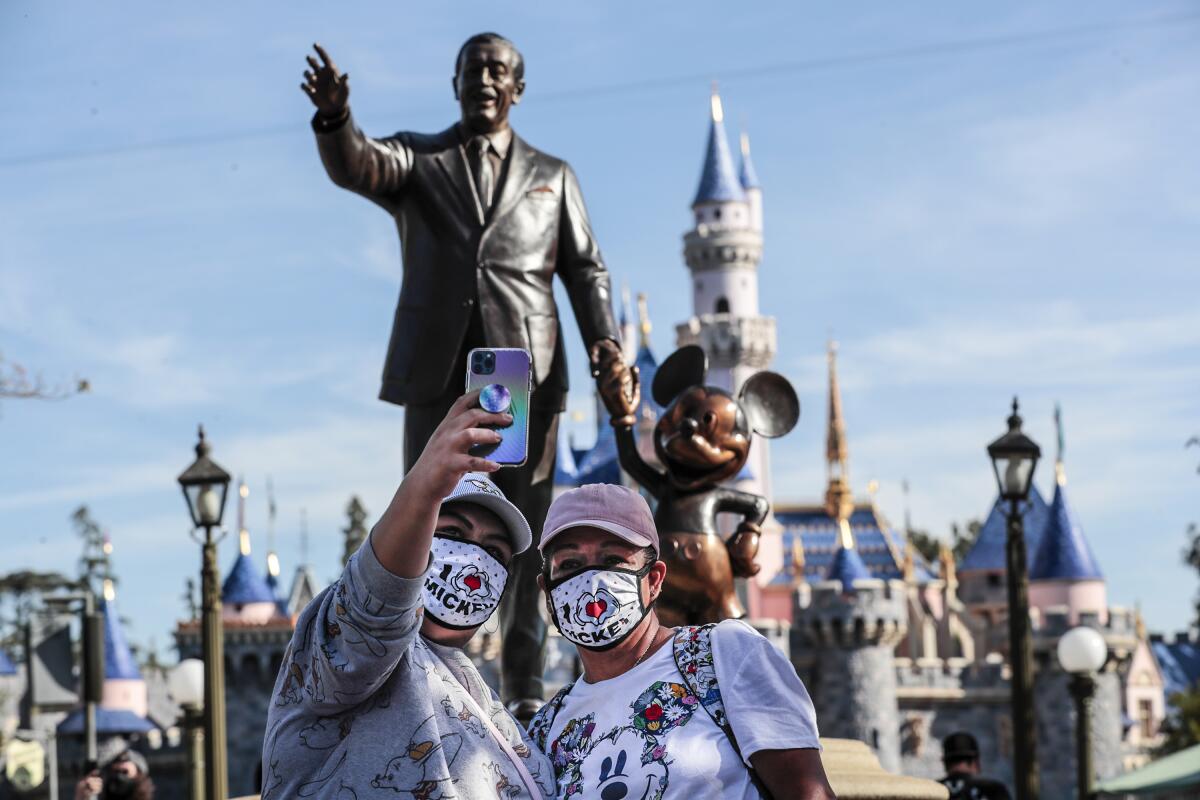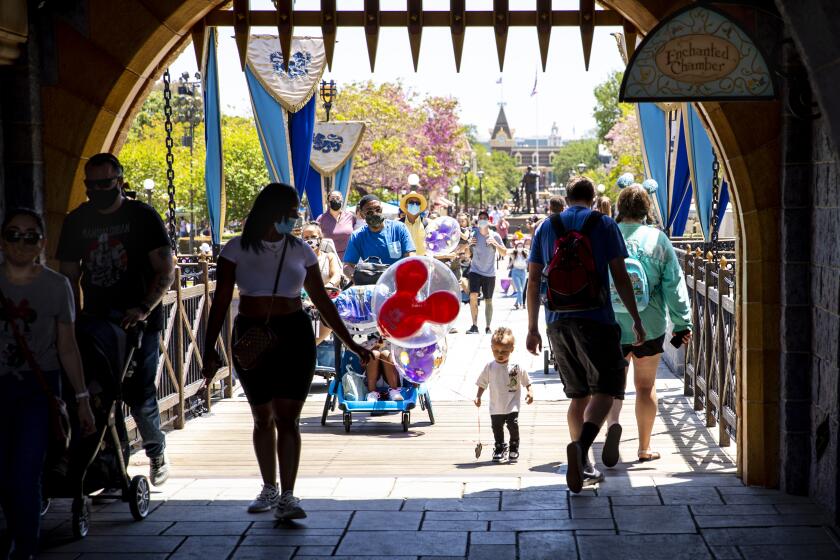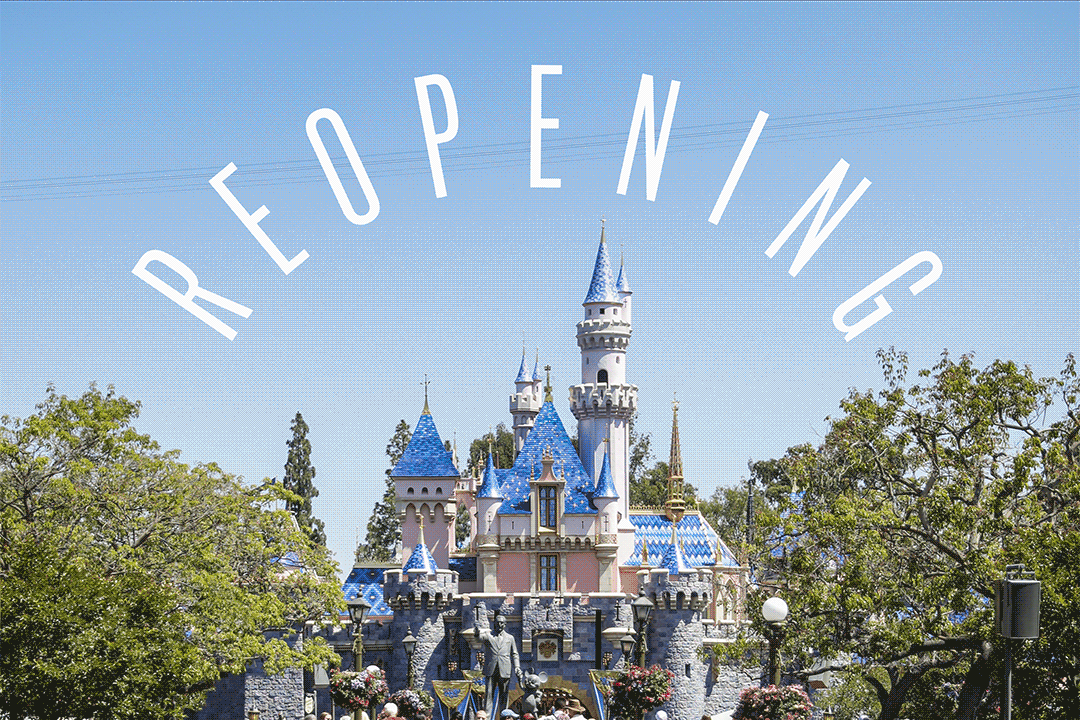Disneyland has a new annual pass program. Here’s everything you need to know

- Share via
The Disneyland Resort has overhauled its 37-year-old annual pass program to help reduce crowding on high-demand days, replacing it with a program that will require visitors to make reservations before going to the theme parks, while continuing to block out access on the busiest days.
By requiring reservations, Disney representatives say, the company hopes to manage how many parkgoers visit Disneyland and California Adventure Park each day, easing the increasingly vexing problem of huge crowds that jam walkways and push wait times for the attractions beyond tolerable levels. Disneyland announced details of the new pass program, dubbed Magic Key, on Tuesday.
“We know this allows us to smooth demand throughout the year,” Disney spokesperson Liz Jaeger said.
Magic Key includes four options, ranging in price from $399 per year for Southern California residents to $1,399 for the option with no block-out days and the greatest flexibility for making reservations.
The new pass program is only for Disneyland and California Adventure Park. The previous annual passes ranged from $419 to $2,199, the latter of which included unlimited visits to parks in Anaheim and Orlando, Fla.
Although the overall prices of the Magic Key passes are lower than Disneyland’s previous annual passes, the number of days parkgoers can visit is now limited by how many block-out dates come with each option and how many reservations will be accepted. Under the previous program, most pass holders could show up to the parks as often as they wanted.
Disneyland, Universal Studios and Magic Mountain are among the California parks returning to stricter mask requirements amid the latest COVID-19 surge.
Disney representatives acknowledged that pass holders may not be able to make reservations even on days allowed by their pass because of park crowding.
Sales of the passes begin Aug. 25.
Here are the options:
- The Dream Key is priced at $1,399 with no block-out dates. The price includes access to both parks and parking, and allows the holder to select as many as six reservation dates at a time. It includes discounts of as much as 20% for merchandise and food and beverages.
- The Believe Key is priced at $949 with 48 block-out dates, most of which fall around Thanksgiving and the December holidays. The price includes access to both parks and a 50% discount on parking and allows the holder to select as many as six reservation dates at a time. Discounts of as much as 10% are offered for merchandise, food and drinks.
- The Enchant Key is priced at $649 with 149 block-out dates; most of June and July and the days around Thanksgiving and Christmas restricted. The price includes access to both parks but does not include parking and allows only four reservation dates at a time. Discounts of as much as 10% are offered for merchandise, food and drinks.
- The Imagine Key, priced at $399, will be sold only to Southern California residents and has 218 block-out dates, with no available weekends and most of the summer blocked out. It allows access to both parks but only two reservation dates can be made at a time. Parking is not included. This option includes 10% discounts on some merchandise, food and drinks.
More than a year after closing due to the pandemic, the theme parks at the Disneyland Resort in Anaheim reopened April 30. Here’s what to expect.
Pass holders who are California residents can still pay for the annual pass on a monthly basis as was allowed under the previous program. When making reservations to visit two parks in one day, the pass holder must pick which to visit in the morning and which to visit after 1 p.m.
Pass holders can make reservations to visit the parks as early as 90 days in advance and can cancel a reservation as late as the night before a visit. If a pass holder fails to show up at the park after making reservations three times, Disney will not allow the pass holder to make new reservations for the following 30 days.
Some longtime holders of the previous pass were not impressed with Disneyland’s new offering.
“The Magic Key offers devout fans less for more within a vague web of rules, regulations, advance reservations and blackout dates that make going to Disneyland as fun and spontaneous as paying income tax,” said Matthew Flynn of Studio City, who along with his husband were annual pass holders for the last 10 years. He said he is going to wait for more details before considering getting a new pass.
Hastin Zylstra of Santa Ana previously used his annual pass to visit the Disneyland Resort nearly weekly but now he is not sure he will buy the new Magic Key.
“I think for me, the question is still out given how I’m not sure how much value I will get out of it in the year,” he said.
The new pass is an attempt to give parkgoers the access they want while letting Disney better manage the crowds, said Martin Lewison, a theme park expert and professor of business management at Farmingdale State College in New York.
“I think Disneyland gave as much back to the annual pass holders as they could, but what they kept was the ability to control capacity,” he said.
The previous annual pass, which launched in 1984 for only $65, was canceled in January, less than a year after Disneyland and California Adventure Park closed due to the COVID-19 pandemic. That closure allowed Disney to rethink the annual pass program, and how to address the long-building problem of overcrowding. The parks reopened April 30.
In its 37-year history, the annual program was expanded, modified and adjusted several times, with various tiers added and block-out days adjusted in response to park attendance.
When the program was canceled, Disney executives hinted that the replacement would be designed to help spread the attendance, ease crowing on high-demand days and increase revenue for the company.
“I don’t think we’ve even scratched the surface in terms of what we can do when we finally restart with some of our programs, in terms of making sure again, that not only do we improve the guest experience, but at the same time get an adequate return to our shareholders,” Bob Chapek, Walt Disney Co. chief executive, said about the annual pass program during an earnings conference call in May.
The problem with the previous annual pass program, according to theme park experts, was that too many Southern California park fans were using their annual passes to crowd the parks, which discouraged visits from out-of-state tourists or international visitors, who tend to spend more per visit than locals.
Although Disney does not release attendance figures, a report by the engineering firm AECOM estimates that in 2019, Disneyland and Disney California Adventure Park had a combined total of 28.4 million visitors. The number of people who hold annual passes has long been believed to hover around 1 million. According to one estimate by financial analysts at UBS, those pass holders have made up 50% of all annual visitors to the Anaheim resort.
Before the previous program was canceled, the least expensive annual pass, the Southern California Select, could be purchased only by Southern California residents and had the highest number of restrictions, including block-out dates on most weekends. It was priced at $419 per year.
The Flex Pass, which could be used by anyone with no restrictions on most Mondays through Thursdays, was priced at $649. Flex Pass holders who wanted to visit on most weekends and during high-demand summer months were required to log onto the Disneyland website or use the resort’s smartphone app to book a reservation. This allowed the parks to manage attendance on high-demand days.
The most expensive annual pass, the Premier Pass, gave guests access to Disney parks in Anaheim and Orlando, Fla., without blocking any dates. It was priced at $2,199.
More to Read
Inside the business of entertainment
The Wide Shot brings you news, analysis and insights on everything from streaming wars to production — and what it all means for the future.
You may occasionally receive promotional content from the Los Angeles Times.













